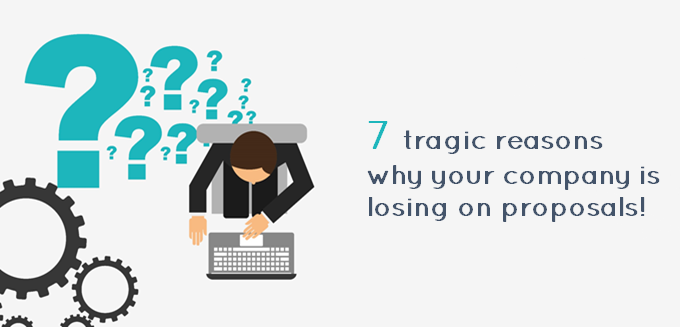When I asked one of my clients what do you know about the prospect, they told me that they have his name number and email ID.
Yes, but what else, I asked?
Not much really. Oh and he works at XYZ company.
Anything about his personal preferences, his flavors, his interests, his day to day challenges in the work place, his age?
No, they don’t tell us these things. Now tell us how we can win more proposals..

Most companies tend to see proposals as deities descended on earth as a beautiful chance to demonstrate what they can do… As the first stage of the sales blast when it, in fact should be one of the final steps.
Let’s get this straight! A proposal is a document confirming previous discussions, not a conversation starter.
The act of impressing and courting should have happened long before, and the proposal should rather serve as a contract waiting to be signed.
Let’s see how a lost proposal uncovers a badly designed sales cycles, inappropriately positioned sales culture, and why most companies lose on most of them.
1. You treat your proposal like laundry list.
Sad but true. What most companies do after they receive a request for proposal is to mention a list of tasks to be performed, man hours and charges. In other words you say this is how much time it takes us to complete this amount of work. This is how efficient we are, and this is what you will pay for our efficiency – or lack thereof.
By doing this you automatically position yourself as a good stop for those who are looking for the lowest possible price. These prospects aren’t looking for value and a partnership type of relationship. Chances are you’ll end up frustrated working with them, or losing them when a lower quote comes their way.
2. You do not speak value
Only those who can’t deliver value talk about being an outsourcing station for the cheapest price possible. Savvy and competent companies position themselves as partners and make their prospect see the engagement as a marketing investment. They do this by being problem oriented. They do not talk about how inexpensive they are; instead, they demonstrate that the absence of this solution will cause the client to lose 10,000 dollars per month.
3. You do not qualify your prospect.
A prospect demonstrates interest in your solution, and the next thing you do is send a proposal with basically all the things you can do for him.
Wrong!
The fastest way to scare prospects off is sending them unsolicited proposals. Do not send a proposal until you have clearly identified the prospect’s need, built enough of a rapo and personal relationship and know the prospect’s budget preference.
4. You are not personal enough
You can be sure that your prospect will get at least a dozen other proposals from other salesmen.
Do you know who is going to win?
The salesman who sent the proposal and asked for his home address to send him a newly launched book on cricket for his birthday. (During one of his calls he had found that both he and the prospect were extremely passionate about cricket.)
The point is not the “gift” itself, it’s the fact that he cared enough to make a connection, and remember it afterwards. Always send your proposals with a personal note and a reminder of a shared moment.
5. Your design sucks
I’ve seen dozens of companies sending a plain Word file as a proposal to ‘large deal’ prospects. They didn’t seem to mind as long as they’ve sent enough number of proposals for the day. Needless to say, barely any of them locked a deal otherwise, they wouldn’t have the need to call me.
This is an era driven by design. Bad design means that there are some rookie freelancers on the other side. Do not defame yourself just because you failed to get the point across because of your design. Design well! Investing in professional proposal software can dramatically enhance the design and effectiveness of your proposals, setting you apart from competitors who rely on outdated methods.
6. You didn’t follow up.
Sending the proposal doesn’t mark the end of the game. Follow up is crucial.
A moment of silence doesn’t mean that the opportunity is lost. This behaviour is part and symptom of a normal sales cycle.
Savvy salesmen know that, and prepare themselves accordingly. They ensure that the prospect keeps getting valuable information that will take him to the final leap. He goes to the Marketing team and prepares series of transaction and follow-up emails for the next few weeks and keeps re-iterating how the company can solve his business challenges.
Persistence is the key. Don’t lose on proposals because you didn’t send one more follow up.
7. You didn’t set up a process.
There are elements and steps in every sales process that are repeatable and others that are unique. A well-defined process will guide you on what to do when. Some details are unique for different prospects such as:
- Current customer metrics and key company information
- The cost to the client of not doing anything to meet its goals
While some of them can be organized via template and reused:
- Campaign goals
- Scope of services and benefits
- Reporting
- Success Metrics
- Timeline
The art of good proposal lies in good packaging. With some keen understanding you’ll be able to extract and re-use templates and format of your best winning proposal.
How do you ensure that your proposal wins the prospect and gets you the business? We’d love to hear from you.








